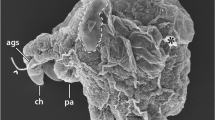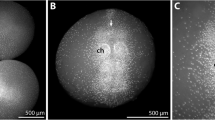Abstract
In recent years, methods for investigating the exo-morphology of zoological specimens have seen large improvements. Among new approaches, auto-fluorescence imaging offers possibilities to document specimens under high resolution without introducing additional artifacts as, for example, seen in scanning electron microscopy (SEM) imaging. Additionally, while SEM imaging is restricted to the outer morphology of the current instar, auto-fluorescence imaging can be used to document changes of the outer morphology of the next instar underneath the cuticle of the current instar. Thus, reinvestigating seemingly well known species with these methods may lead to interesting new insights. Here we reinvestigate the late embryonic development of the xiphosuran (“sword tail”) Limulus polyphemus, which is often treated as a proxy for early eucheliceratan evolution. In addition to entire specimens, the appendages of the embryos were dissected off and documented separately with composite-autofluorescence microscopy. Based on these data, we can distinguish six developmental stages. These stages do not match exactly the formerly described stages, as these were largely based on SEM investigation. Our stages appear to represent earlier or later phases within what has in other studies been identified as one stage. This finer subdivision is visible as we can see the developing cuticle under the outer cuticle. In comparison to data from fossil xiphosurans, our results and those of other studies on the ontogeny of L. polyphemus point to a derived mode of development in this species, which argues against the idea of L. polyphemus as a “living fossil.”








Similar content being viewed by others
References
Anderson LI (1994) Xiphosurans from the Westphalian D of the Radstock Basin. Proc Geol Assoc 105(4):265–275. https://doi.org/10.1016/S0016-7878(08)80179-4
Botton ML, Tankersley RA, Loveland RE (2010) Developmental ecology of the American horseshoe crab Limulus polyphemus. Curr Zool 56(5):550–562
Brauckmann C (1982) Der Schwertschwanz Euproops (Xiphosurida, Limulina, Euproopacea) aus dem Ober-Karbon des Piesbergs bei Osnabrück. Osnabrücker naturwissenschaftliche Mitteilungen 9:17–26
Brown GG, Clapper DL (1981) Procedures for maintaining adults, collecting gametes, and culturing embryos and juveniles of the horseshoe crab Limulus polyphemus L. In: Hinegardner R, Atz J, Fayet R (eds) Marine invertebrates—laboratory animal management. National Academy Press, Washington DC, pp 268–290
Darwin CR (1859) On the origin of species by means of natural selection, or the preservation of favoured races in the struggle for life. John Murray, London
Dunlop JA (2010) Geological history and phylogeny of Chelicerata. Arthropod Struct Dev 39(2):124–142
Dunlop JA, Penney D, Tetlie OE, Anderson LI (2008) How many species of fossil arachnids are there? J Arachnol 36(2):267–272
Farley RD (2010) Book gill development in embryos and first and second instars of the horseshoe crab Limulus polyphemus L. (Chelicerata, Xiphosura). Arthropod Struct Dev 39:369–381
Garwood RJ, Dunlop J (2014) Three-dimensional reconstruction and the phylogeny of extinct chelicerate orders. Peer J 2:e641
Haug JT, Haug C, Ehrlich M (2008) First fossil stomatopod larva (Arthropoda: Crustacea) and a new way of documenting Solnhofen fossils (Upper Jurassic, Southern Germany). Palaeodiversity 1:103–109
Haug C, Haug JT, Waloszek D, Maas A, Frattigiani R, Liebau S (2009) New methods to document fossils from lithographic limestones of southern Germany and Lebanon. Palaeontol Electron 12:art.12.3.6T
Haug JT, Haug C, Waloszek D, Schweigert G (2011a) The importance of lithographic limestones for revealing ontogenies in fossil crustaceans. Swiss J Geosci 104(Supplement 1):S85–S98
Haug JT, Haug C, Kutschera V, Mayer G, Maas A, Liebau S, Castellani C, Wolfram U, Clarkson ENK, Waloszek D (2011b) Autofluorescence imaging, an excellent tool for comparative morphology. J Microsc 244:259–272
Haug C, Mayer G, Kutschera V, Waloszek D, Maas A, Haug JT (2011c) Imaging and documenting gammarideans. Intern J Zool:art.380829
Haug C, Van Roy P, Leipner A, Funch P, Rudkin DM, Schöllmann L, Haug JT (2012a) A holomorph approach to xiphosuran evolution—a case study on the ontogeny of Euproops. Dev Genes Evol 222:253–268
Haug C, Sallam WS, Maas A, Waloszek D, Kutschera V, Haug JT (2012b) Tagmatization in Stomatopoda—reconsidering functional units of modern-day mantis shrimps (Verunipeltata, Hoplocarida) and implications for the interpretation of fossils. Front Zool 9:art.31
Haug JT, Briggs DEG, Haug C (2012c) Morphology and function in the Cambrian Burgess Shale megacheiran arthropod Leanchoilia superlata and the application of a descriptive matrix. BMC Evol Biol 12:art. 162
Haug C, Shannon KR, Nyborg T, Vega FJ (2013) Isolated mantis shrimp dactyli from the Pliocene of North Carolina and their bearing on the history of Stomatopoda. Bol Soc Geol Mex 65:273–284
Haug C, Rötzer M (2018) The ontogeny of the 300 million year old xiphosuran Euproops danae (Euchelicerata) and implications for resolving the Euproops species complex. Dev Genes Evol. https://doi.org/10.1007/s00427-018-0604-0 this issue
Hennig W (1965) Phylogenetic systematics. Ann Rev Entomol 10:97–116
Hopkins MJ, Lidgard S (2012) Evolutionary mode routinely varies among morphological traits within fossil species lineages. PNAS 109(50):20520–20525
Hunt G, Hopkins MJ, Lidgard S (2015) Simple versus complex models of trait evolution and stasis as a response to environmental change. PNAS 112(16):4885–4890
Jegla TC, Costlow JD (1982) Temperature and salinity effects on developmental and early posthatch stages of Limulus. In: Bonaventura J, Bonaventura C, Tesh S (eds) Physiology and biology of horseshoe crabs. Alan R. Liss, New York, pp 103–113
Kingsley JS (1892) The embryology of Limulus. J Morphol 7:35–68
Lamsdell JC (2013) Revised systematics of Palaeozoic ‘horseshoe crabs’ and the myth of monophyletic Xiphosura. Zool J Linn Soc 167:1–27
Lamsdell JC (2016) Horseshoe crab phylogeny and independent colonizations of fresh water: ecological invasion as a driver for morphological innovation. Palaeontology 59(2):181–194
Lamsdell JC, Briggs DEG, Liu HP, Witzke BJ, McKay RM (2015) A new Ordovician arthropod from the Winneshiek Lagerstätte of Iowa (USA) reveals the ground plan of eurypterids and chasmataspidids. Sci Nature 102(9–10):art. 63
Liu Y, Haug JT, Haug C, Briggs DEG, Hou X (2014) A 520 million-year-old chelicerate larva. Nature Comm 5:art. 4440
Liu Y, Melzer RR, Haug JT, Haug C, Briggs DEG, Hörnig MK, He Y-y, Hou X (2016) Three-dimensionally preserved minute larva of a great-appendage arthropod from the early Cambrian Chengjiang biota. Proc Nat Acad Sci USA (PNAS) 113:5542–5546
Mittmann B (2004) Die Embryologie des Pfeilschwanzkrebses Limulus polyphemus (Xiphosura, Chelicerata) und anderer Arthropoden unter besonderer Berücksichtigung der Neurogenese. Dissertation, Humboldt-University of Berlin
Racheboeuf PR, Vannier J, Anderson LI (2002) A new three-dimensionally preserved xiphosuran chelicerate from the Montceau-Les-Mines Lagerstätte (Carboniferous, France). Palaeontology 45:125–147
Rötzer MMA, Haug JT (2015) Larval development of the European lobster and how small heterochronic shifts lead to a more pronounced metamorphosis. Intern J Zool:art. 345172
Rudkin DM, Young GA, Nowlan GS (2008) The oldest horseshoe crab: a new xiphosurid from Late Ordovician Konservat-Lagerstatten deposits, Manitoba, Canada. Palaeontology 51:1–9
Saltin BD, Haug C, Haug JT (2016) How metamorphic is holometabolous development? Using microscopical methods to look inside the scorpionfly (Panorpa) pupa (Mecoptera, Panorpidae). Spixiana 39:105–118
Scholl G (1977) Beiträge zur Embryonalentwicklung von Limulus polyphemus L. (Chelicerata, Xiphosura). Zoomorphologie 86:99–154
Sekiguchi K, Sugita H (1980) Systematics and hybridization in the four living species of horseshoe crabs. Evolution 34:712–718
Sekiguchi K, Yamamichi Y, Costlow JD (1982) Horseshoe crab developmental studies I. Normal embryonic development of Limulus polyphemus compared with Tachypleus tridentatus. In: Bonaventura J, Bonaventura C, Tesh S (eds) Physiology and biology of horseshoe crabs: studies on normal and environmentally stressed animals. Alan R. Liss, New York, pp 53–73
Selden PA, Lamsdell JC, Qi L (2015) An unusual euchelicerate linking horseshoe crabs and eurypterids, from the Lower Devonian (Lochkovian) of Yunnan, China. Zool Scr 44(6):645–652
Servais T, Harper DA, Munnecke A, Owen AW, Sheehan PM (2009) Understanding the Great Ordovician Biodiversification Event (GOBE): Influences of paleogeography, paleoclimate, or paleoecology. GSA Today 19(4):4–10
Shultz JW (2007) A phylogenetic analysis of the arachnid orders based on morphological characters. Zool J Linn Soc 150(2):221–265
Shuster CN Jr, Sekiguchi K (2003) Growing up takes about ten years and eighteen stages. In: Shuster CN Jr, Barlow RB, Brockmann HJ (eds) The American horseshoe crab. Harvard University Press, Cambridge, pp 103–132
Thenius E (2000) Lebende Fossilien: Oldtimer der Pflanzen- und Tierwelt - Zeugen der Vorzeit. Dr. Friedrich Pfeil, München
Van Roy P, Orr PJ, Botting JP, Muir LA, Vinther J, Lefebvre B, el Hariri K, Briggs DEG (2010) Ordovician faunas of Burgess Shale type. Nature 465:215–218
Waloszek D, Dunlop JA (2002) A larval sea spider (Arthropoda: Pycnogonida) from the Upper Cambrian ‘Orsten’ of Sweden, and the phylogenetic position of pycnogonids. Palaeontology 45:421–446
Webby BD, Droser ML, Paris F, Percival I (2004) The Great Ordovician Biodiversification Event. Columbia University Press, New York
Wolff C, Scholtz G (2008) The clonal composition of biramous and uniramous arthropod limbs. Proc R Soc London B 275:1023–1028
Acknowledgements
We are very grateful to Eric Lazo-Wasem and Daniel Drew, Yale Peabody Museum, New Haven, for collecting, rearing and fixing the specimens. Jakob Krieger, University of Greifswald, is thanked for help with handling the specimens. We would like to thank Joachim T. Haug, LMU Munich, for his technical assistance and valuable discussions about xiphosuran development and tagmatization. Steffen Harzsch, University of Greifswald, and J. Matthias Starck, LMU Munich, are thanked for providing lab space and general support. CH was kindly funded by the Equal Opportunities Sponsorship of the LMU. This study is part of a project kindly funded by the German Research Foundation (DFG) under HA 7066/3-1.
Author information
Authors and Affiliations
Corresponding author
Additional information
Communicated by Nikola-Michael Prpic
Rights and permissions
About this article
Cite this article
Haug, C., Rötzer, M.A.I.N. The ontogeny of Limulus polyphemus (Xiphosura s. str., Euchelicerata) revised: looking “under the skin”. Dev Genes Evol 228, 49–61 (2018). https://doi.org/10.1007/s00427-018-0603-1
Received:
Accepted:
Published:
Issue Date:
DOI: https://doi.org/10.1007/s00427-018-0603-1




